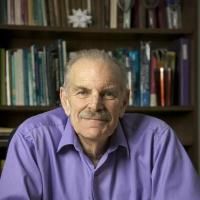The impact of host immune status on the within-host and population dynamics of antigenic immune escape.
Date
2012-10-07
Journal Title
Journal ISSN
Volume Title
Repository Usage Stats
views
downloads
Citation Stats
Abstract
Antigenically evolving pathogens such as influenza viruses are difficult to control owing to their ability to evade host immunity by producing immune escape variants. Experimental studies have repeatedly demonstrated that viral immune escape variants emerge more often from immunized hosts than from naive hosts. This empirical relationship between host immune status and within-host immune escape is not fully understood theoretically, nor has its impact on antigenic evolution at the population level been evaluated. Here, we show that this relationship can be understood as a trade-off between the probability that a new antigenic variant is produced and the level of viraemia it reaches within a host. Scaling up this intra-host level trade-off to a simple population level model, we obtain a distribution for variant persistence times that is consistent with influenza A/H3N2 antigenic variant data. At the within-host level, our results show that target cell limitation, or a functional equivalent, provides a parsimonious explanation for how host immune status drives the generation of immune escape mutants. At the population level, our analysis also offers an alternative explanation for the observed tempo of antigenic evolution, namely that the production rate of immune escape variants is driven by the accumulation of herd immunity. Overall, our results suggest that disease control strategies should be further assessed by considering the impact that increased immunity--through vaccination--has on the production of new antigenic variants.
Type
Department
Description
Provenance
Citation
Permalink
Published Version (Please cite this version)
Publication Info
Luo, Shishi, Michael Reed, Jonathan C Mattingly and Katia Koelle (2012). The impact of host immune status on the within-host and population dynamics of antigenic immune escape. J R Soc Interface, 9(75). pp. 2603–2613. 10.1098/rsif.2012.0180 Retrieved from https://hdl.handle.net/10161/10245.
This is constructed from limited available data and may be imprecise. To cite this article, please review & use the official citation provided by the journal.
Collections
Scholars@Duke

Michael C. Reed
Professor Reed is engaged in a large number of research projects that involve the application of mathematics to questions in physiology and medicine. He also works on questions in analysis that are stimulated by biological questions. For recent work on cell metabolism and public health, go to sites@duke.edu/metabolism.
Since 2003, Professor Reed has worked with Professor Fred Nijhout (Duke Biology) to use mathematical methods to understand regulatory mechanisms in cell metabolism. Most of the questions studied are directly related to public health questions. A primary topic of interest has been liver cell metabolism where Reed and Nijhout have created mathematical models for the methionine cycle, the folate cycle, and glutathione metabolism. The goal is to understand the system behavior of these parts of cell metabolism. The models have enabled them to answer biological questions in the literature and to give insight into a variety of disease processes and syndromes including: neural tube defects, Down’s syndrome, autism, vitamin B6 deficiency, acetaminophen toxicity, and arsenic poisoning.
A second major topic has been the investigation of dopamine and serotonin metabolism in the brain; this is collaborative work with Professor Nijhiout and with Janet Best, a mathematician at The Ohio State University. The biochemistry of these neurotransmitters affects the electrophysiology of the brain and the electrophysiology affects the biochemistry. Both affect gene expression, the endocrine system, and behavior. In this complicated situation, especially because of the difficulty of experimentation, mathematical models are an essential investigative tool that can shed like on questions that are difficult to get at experimentally or clinically. The models have shed new light on the mode of action of selective serotonin reuptake inhibitors (used for depression), the interactions between the serotonin and dopamine systems in Parkinson’s disease and levodopa therapy, and the interactions between histamine and serotonin.
Recent work on homeostatic mechanisms in cell biochemistry in health and disease have shown how difficult the task of precision medicine is. A gene polymorphism may make a protein such as an enzyme less effective but often the system compensates through a variety of homeostatic mechanisms. So even though an individual's genotype is different, his or her phenotype may not be different. The individuals with common polymorphisms tend tend to live on homeostatic plateaus and only those individuals near the edges of the plateau are at risk for disease processes. Interventions should try to enlarge the homeostatic plateau around the individual's genotype.
Other areas in which Reed uses mathematical models to understand physiological questions include: axonal transport, the logical structure of the auditory brainstem, hyperacuity in the auditory system, models of pituitary cells that make luteinizing hormone and follicle stimulating hormone, models of maternal-fetal competition, models of the owl’s optic tectum, and models of insect metabolism.
For general discussions of the connections between mathematics and biology, see his articles: ``Why is Mathematical Biology so Hard?,'' 2004, Notices of the AMS, 51, pp. 338-342, and ``Mathematical Biology is Good for Mathematics,'' 2015, Notices of the AMS, 62, pp., 1172-1176.
Often, problems in biology give rise to new questions in pure mathematics. Examples of work with collaborators on such questions follow:
Laurent, T, Rider, B., and M. Reed (2006) Parabolic Behavior of a Hyberbolic Delay Equation, SIAM J. Analysis, 38, 1-15.
Mitchell, C., and M. Reed (2007) Neural Timing in Highly Convergent Systems, SIAM J. Appl. Math. 68, 720-737.
Anderson,D., Mattingly, J., Nijhout, F., and M. Reed (2007) Propagation of Fluctuations in Biochemical Systems, I: Linear SSC Networks, Bull. Math. Biol. 69, 1791-1813.
McKinley S, Popovic L, and M. Reed M. (2011) A Stochastic compartmental model for fast axonal transport, SIAM J. Appl. Math. 71, 1531-1556.
Lawley, S. Reed, M., Mattingly, S. (2014), Sensitivity to switching rates in stochastically switched ODEs,'' Comm. Math. Sci. 12, 1343-1352.
Lawley, S., Mattingly, J, Reed, M. (2015), Stochastic switching in infinite dimensions with applications to parabolic PDE, SIAM J. Math. Anal. 47, 3035-3063.

Jonathan Christopher Mattingly
Jonathan Christopher Mattingly grew up in Charlotte, NC where he attended Irwin Ave elementary and Charlotte Country Day. He graduated from the NC School of Science and Mathematics and received a BS is Applied Mathematics with a concentration in physics from Yale University. After two years abroad with a year spent at ENS Lyon studying nonlinear and statistical physics on a Rotary Fellowship, he returned to the US to attend Princeton University where he obtained a PhD in Applied and Computational Mathematics in 1998. After 4 years as a Szego assistant professor at Stanford University and a year as a member of the IAS in Princeton, he moved to Duke in 2003. He is currently a Professor of Mathematics and of Statistical Science.
His expertise is in the longtime behavior of stochastic system including randomly forced fluid dynamics, turbulence, stochastic algorithms used in molecular dynamics and Bayesian sampling, and stochasticity in biochemical networks.
Since 2013 he has also been working to understand and quantify gerrymandering and its interaction of a region's geopolitical landscape. This has lead him to testify in a number of court cases including in North Carolina, which led to the NC congressional and both NC legislative maps being deemed unconstitutional and replaced for the 2020 elections.
He is the recipient of a Sloan Fellowship and a PECASE CAREER award. He is also a fellow of the IMS and the AMS. He was awarded the Defender of Freedom award by Common Cause for his work on Quantifying Gerrymandering.
Unless otherwise indicated, scholarly articles published by Duke faculty members are made available here with a CC-BY-NC (Creative Commons Attribution Non-Commercial) license, as enabled by the Duke Open Access Policy. If you wish to use the materials in ways not already permitted under CC-BY-NC, please consult the copyright owner. Other materials are made available here through the author’s grant of a non-exclusive license to make their work openly accessible.
